Modified U Slot Patch Antenna with Large Frequency Ratio for Vehicle-to-Vehicle Communication
Abstract
:1. Introduction
2. Design Procedures for the Dual-Band Antenna
2.1. Design I: Dual-Band Patch Antenna
2.2. Design II: Dual-Band Patch Antenna
3. Fabricated and Measured Dual-Band Antenna with Enhanced Bandwidth
3.1. Measured Results
3.2. Comparison with Other Dual-Band Antennas
4. Conclusions
- Frequency tunability: This antenna design proposes a frequency-tunable dual-band patch antenna with a high-frequency ratio that can be tuned between 5.9 GHz and 28 GHz.
- Reduced harmonics between the two bands: The design was optimized for a frequency that included the width and length parameters for the lower band patch. By optimizing the upper patch (lower band patch) design for 5.9 GHz, it was found that the higher-order harmonics at frequencies above 5.9 GHz were reduced because of the lack of proper coupling. Therefore, optimizing the design of the upper patch is a tool that can be used to reduce the effects of harmonics and higher-order modes that could occur at other frequencies.
- Bandwidth improvement at the upper band: slits introduced additional resonance for the small patch. As a result, the additional resonances were well-coupled to the patch resonance, enhancing antenna bandwidth. In our design, the bandwidth at the upper-frequency band is improved from 8% to 16% by adding parallel slots near the inset-feed line.
- High gain at both bands: The designed dual-band antenna offers a high peak gain of 7.7 dBi in the DSRC band and 6.38 dBi in the mm-wave band. Both antennas radiate in the boresight direction.; and
- Single-layer structure, simple design, and low-cost PCB fabrication.
Author Contributions
Funding
Data Availability Statement
Conflicts of Interest
References
- Vehicle-to-Vehicle Communication, NHTSA. Available online: https://www.nhtsa.gov/technology-innovation/vehicle-vehicle-communication#nhtsa-in-action (accessed on 2 December 2021).
- Govindarajulu, S.R.; Alwan, E.A. Range Optimization for DSRC and 5G Millimeter-Wave Vehicle-to-Vehicle Communication Link. In Proceedings of the 2019 International Workshop on Antenna Technology (iWAT), Miami, FL, USA, 3–6 March 2019; pp. 228–230. [Google Scholar] [CrossRef]
- Mok, W.C.; Wong, S.H.; Luk, K.M.; Lee, K.F. Single-Layer Single-Patch Dual-Band and Triple-Band Patch Antennas. IEEE Trans. Antennas Propag. 2013, 61, 4341–4344. [Google Scholar] [CrossRef]
- Zhang, X.Y.; Zhang, Y.; Pan, Y.; Duan, W. Low-Profile Dual-Band Filtering Patch Antenna and Its Application to LTE MIMO System. IEEE Trans. Antennas Propag. 2017, 65, 103–113. [Google Scholar] [CrossRef]
- Liu, W.; Wu, C.; Chu, N. A Compact CPW-Fed Slotted Patch Antenna for Dual-Band Operation. IEEE Antennas Wirel. Propag. Lett. 2010, 9, 110–113. [Google Scholar] [CrossRef]
- Nepa, P.; Manara, G.; Serra, A.A.; Nenna, G. Multiband PIFA for WLAN applications. IEEE Antennas Wirel. Propag. Lett. 2005, 4, 349–350. [Google Scholar] [CrossRef]
- Govindarajulu, S.R.; Hokayem, R.; Tarek, M.N.A.; Guerra, M.R.; Alwan, E.A. Low Profile Dual-Band Shared Aperture Array for Vehicle-to-Vehicle Communication. IEEE Access 2021, 9, 147082–147090. [Google Scholar] [CrossRef]
- Zhang, J.; Wu, W.; Fang, D. Dual-Band and Dual-Circularly Polarized Shared-Aperture Array Antennas with Single-Layer Substrate. IEEE Trans. Antennas Propag. 2016, 64, 109–116. [Google Scholar] [CrossRef]
- Mao, C.-X.; Gao, S.; Wang, Y.; Chu, Q.-X.; Yang, X.-X. Dual-Band Circularly Polarized Shared-Aperture Array for C -/ X -Band Satellite Communications. IEEE Trans. Antennas Propag. 2017, 65, 5171–5178. [Google Scholar] [CrossRef]
- Govindarajulu, S.R.; Hokayem, R.; Alwan, E.A. Dual-Band Antenna Array for 5.9 GHz DSRC and 28 GHz 5G Vehicle to Vehicle communication. In Proceedings of the 2020 IEEE International Symposium on Antennas and Propagation and North American Radio Science Meeting, Montreal, QC, Canada, 5–10 July 2020; pp. 1583–1584. [Google Scholar] [CrossRef]
- Sun, Y.X.; Leung, K.W.; Lu, K. Compact Dual Microwave/Millimeter-Wave Planar Shared-Aperture Antenna for Vehicle-to-Vehicle/5G Communications. IEEE Trans. Veh. Technol. 2021, 70, 5071–5076. [Google Scholar] [CrossRef]
- Yassin, M.E.; Mohamed, H.A.; Abdallah, E.A.F.; El-Hennawy, H.S. Single-fed 4G/5G multiband 2.4/5.5/28 GHz antenna. Iet. Microwaves Antennas Propag. 2019, 13, 286–290. [Google Scholar] [CrossRef]
- Xu, G.; Peng, H.; Shao, Z.; Zhou, L.; Zhang, Y.; Yin, W. Dual-Band differential shifted-feed microstrip grid array antenna with two parasitic patches. IEEE Trans. Antennas Propag. 2020, 68, 2434–2439. [Google Scholar] [CrossRef]
- Guo, Y.Q.; Pan, Y.M.; Zheng, S.Y.; Lu, K. A Singly-Fed Dual-Band Microstrip Antenna for Microwave and Millimeter-Wave Applications in 5G Wireless Communication. IEEE Trans. Veh. Technol. 2021, 70, 5419–5430. [Google Scholar] [CrossRef]
- Su, Y.; Lin, X.Q.; Fan, Y. Dual-Band Coaperture Antenna Based on a Single-Layer Mode Composite Transmission Line. IEEE Trans. Antennas Propag. 2019, 67, 4825–4829. [Google Scholar] [CrossRef]
- Li, X.; Yang, S.; Nie, Z. A novel dual-band patch antenna with high-frequency band ratio. In Proceedings of the 2013 Cross-Strait Quad-Regional Radio Science and Wireless Technology Conference, Chengdu, China, 21–25 July 2013; pp. 269–272. [Google Scholar] [CrossRef]
- Feng, L.Y.; Leung, K.W. Dual-frequency folded-parallel-plate antenna with large frequency ratio. IEEE Trans. Antennas Propag. 2016, 64, 340–345. [Google Scholar] [CrossRef]
- Zheng, S.Y. A Dual-Band Antenna accross Microwave and Millimeter-wave Frequency Bands. In Proceedings of the 2018 International Applied Computational Electromagnetics Society Symposium—China (ACES), Beijing, China, 29 July–1 August 2018; pp. 1–2. [Google Scholar] [CrossRef]
- Serup, D.E.; Pedersen, G.F.; Zhang, S. Dual-Band Shared Aperture Reflectarray and Patch Antenna Array for S- and Ka-Bands. IEEE Trans. Antennas Propag. 2022, 70, 2340–2345. [Google Scholar] [CrossRef]
- Balanis, A. Antenna Theory: Analysis and Design, 3rd ed.; Wiley-Interscience: Hoboken, NJ, USA, 2005; Chapter 14. [Google Scholar]
- Wang, D.; Chan, C.H. Multiband antenna for wifi and wigig communications. IEEE Antennas Wirel. Propag. Lett. 2016, 15, 309–312. [Google Scholar] [CrossRef]

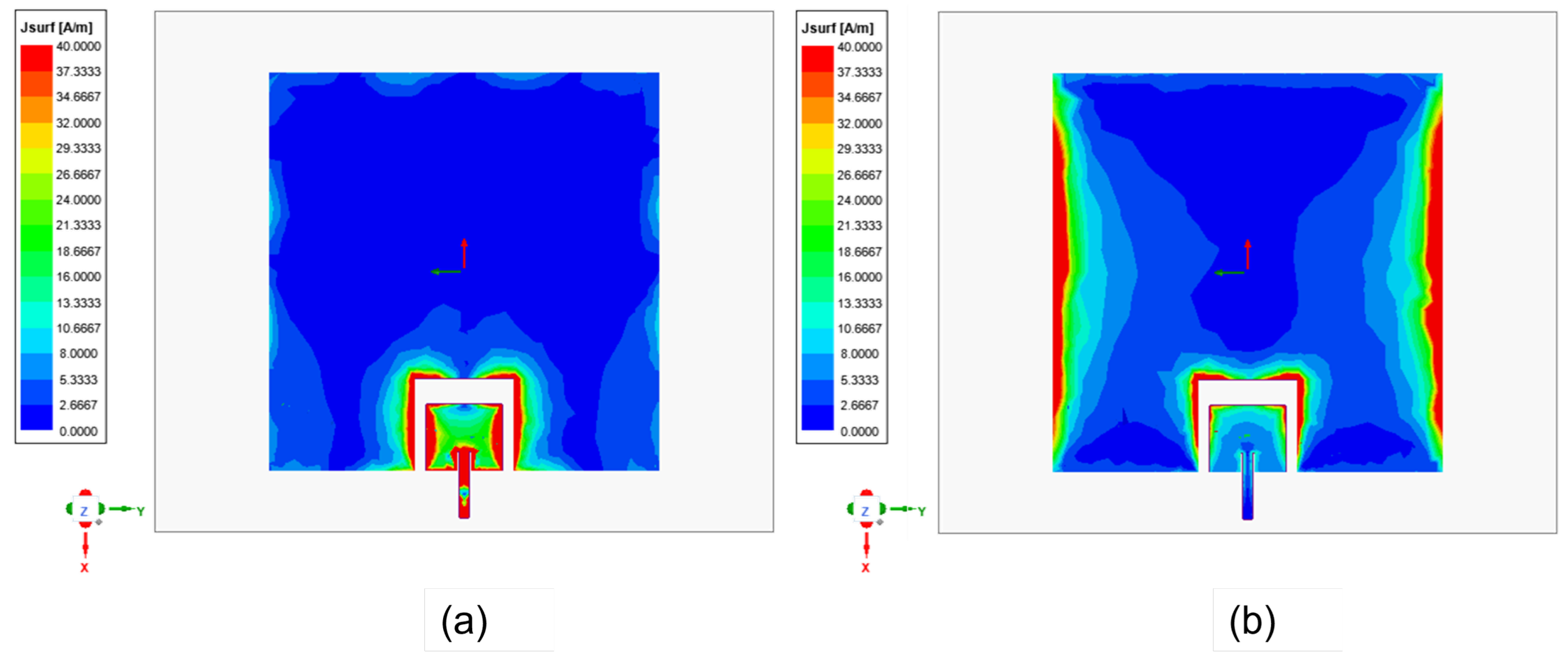

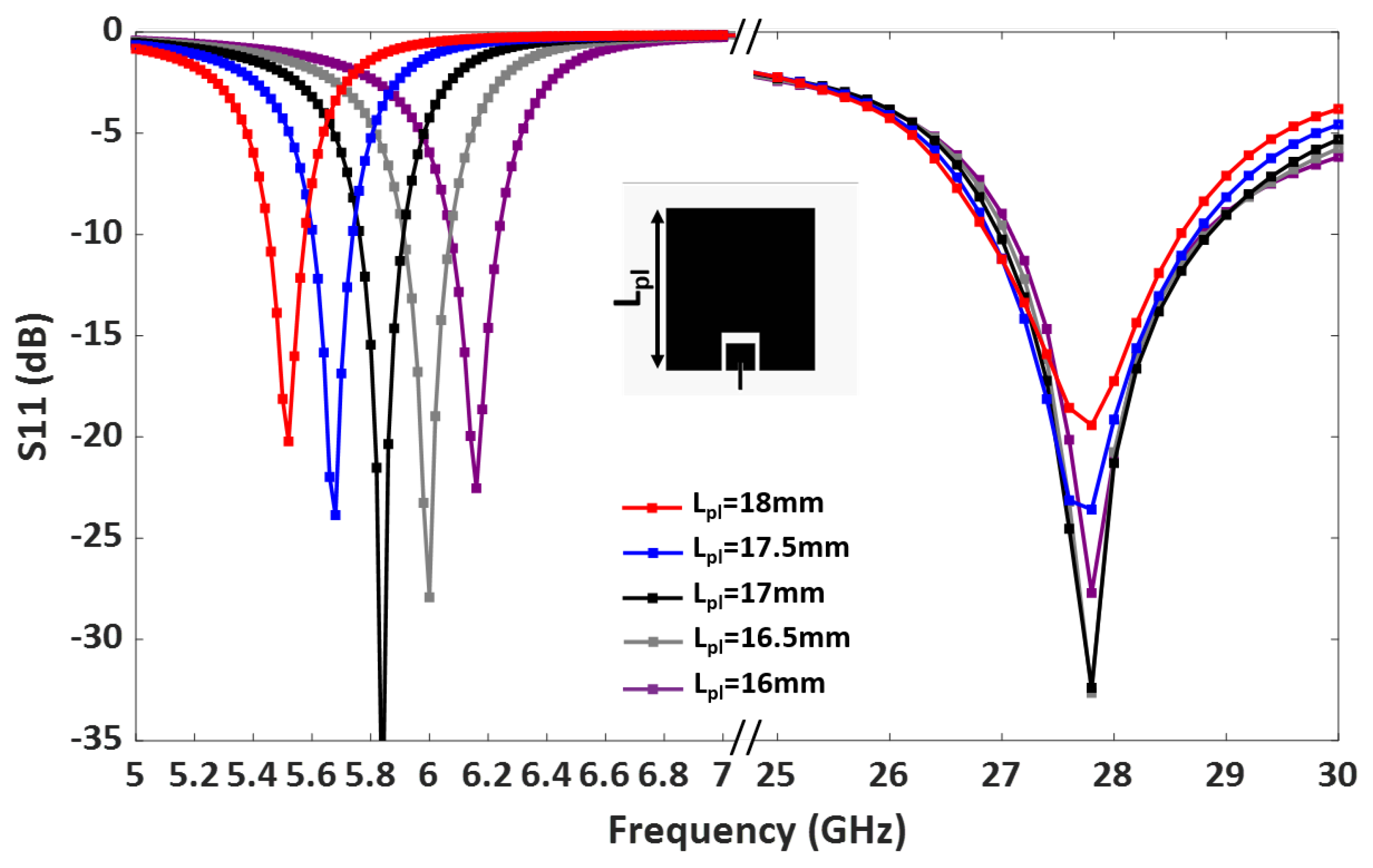

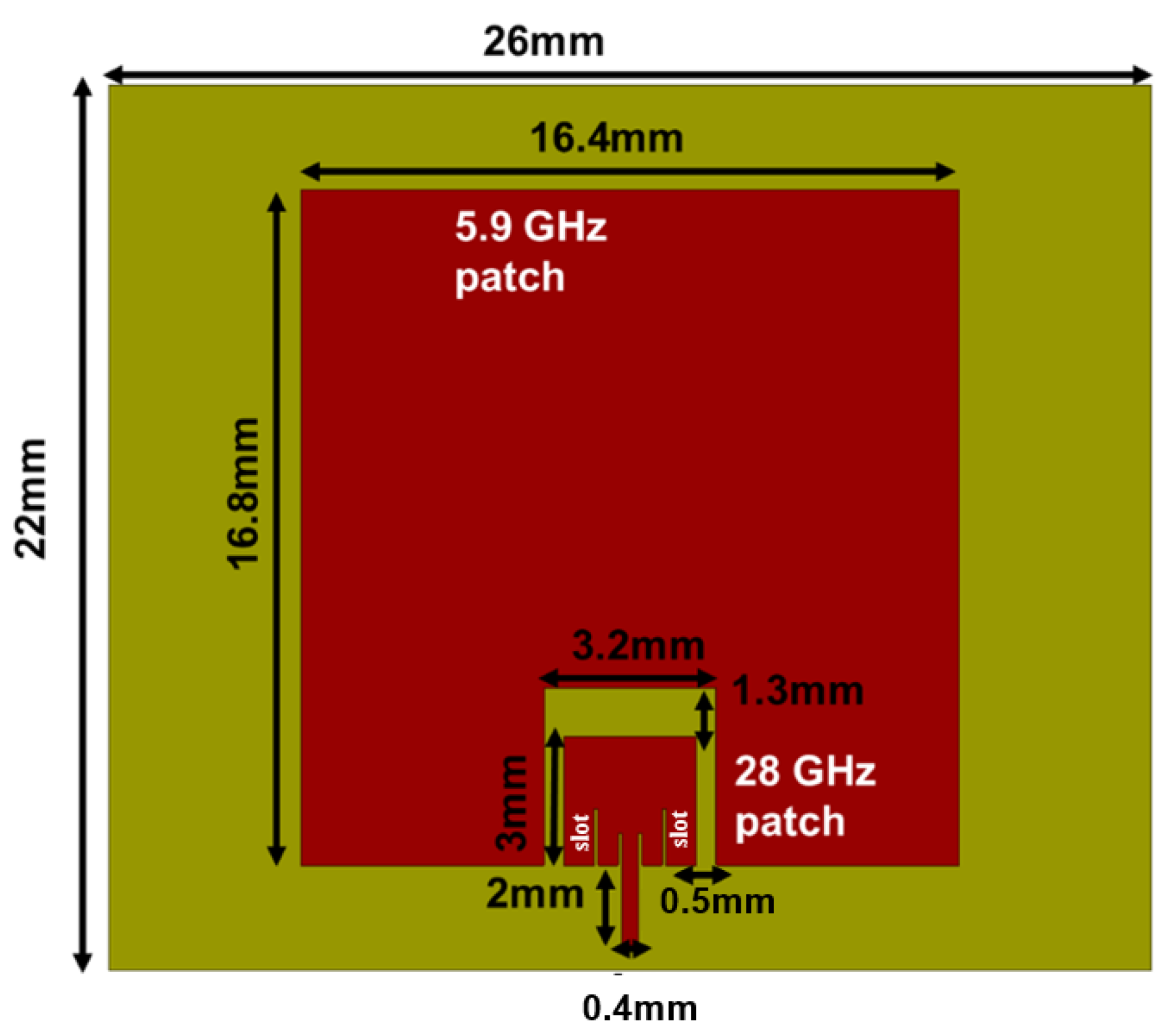
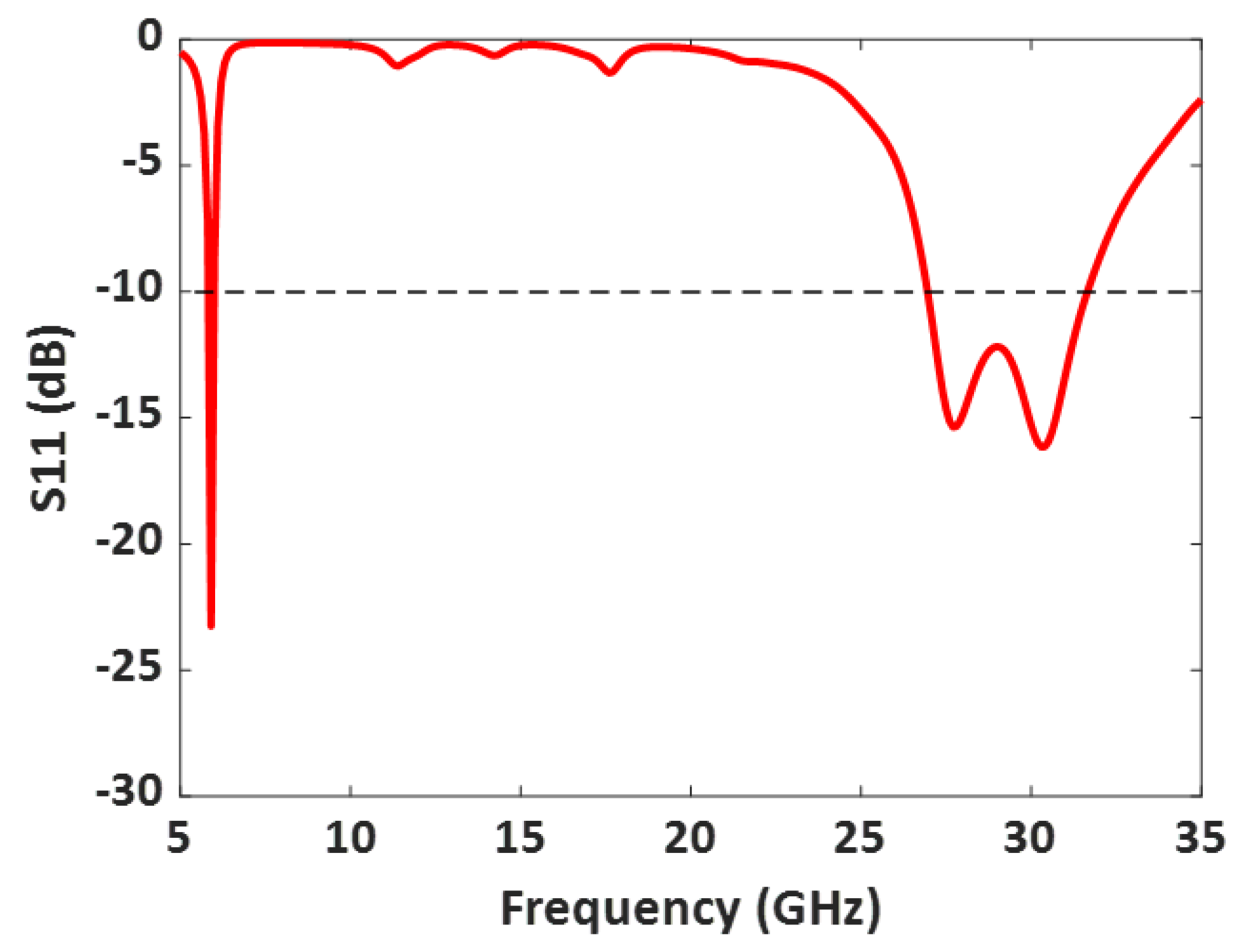
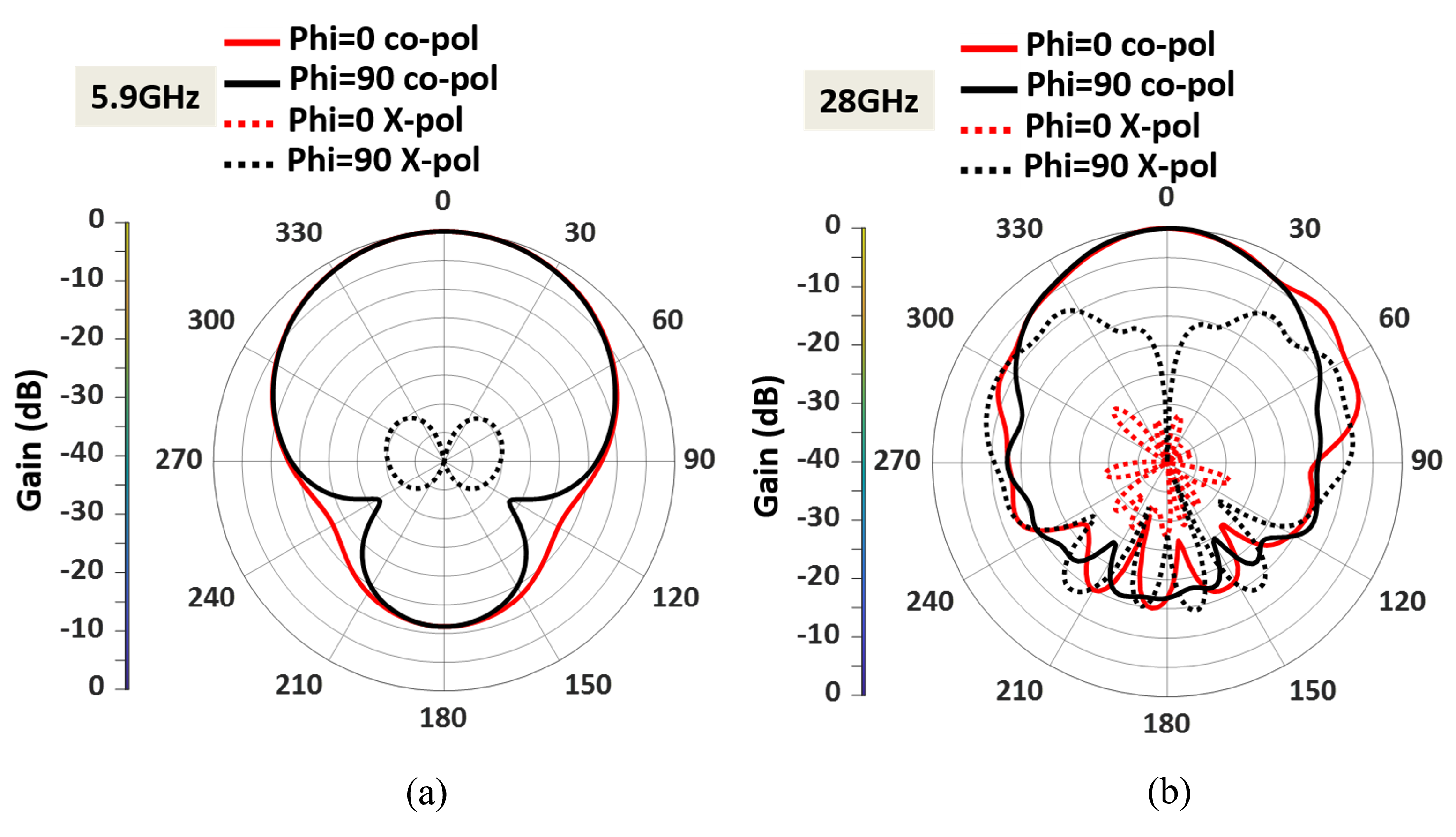
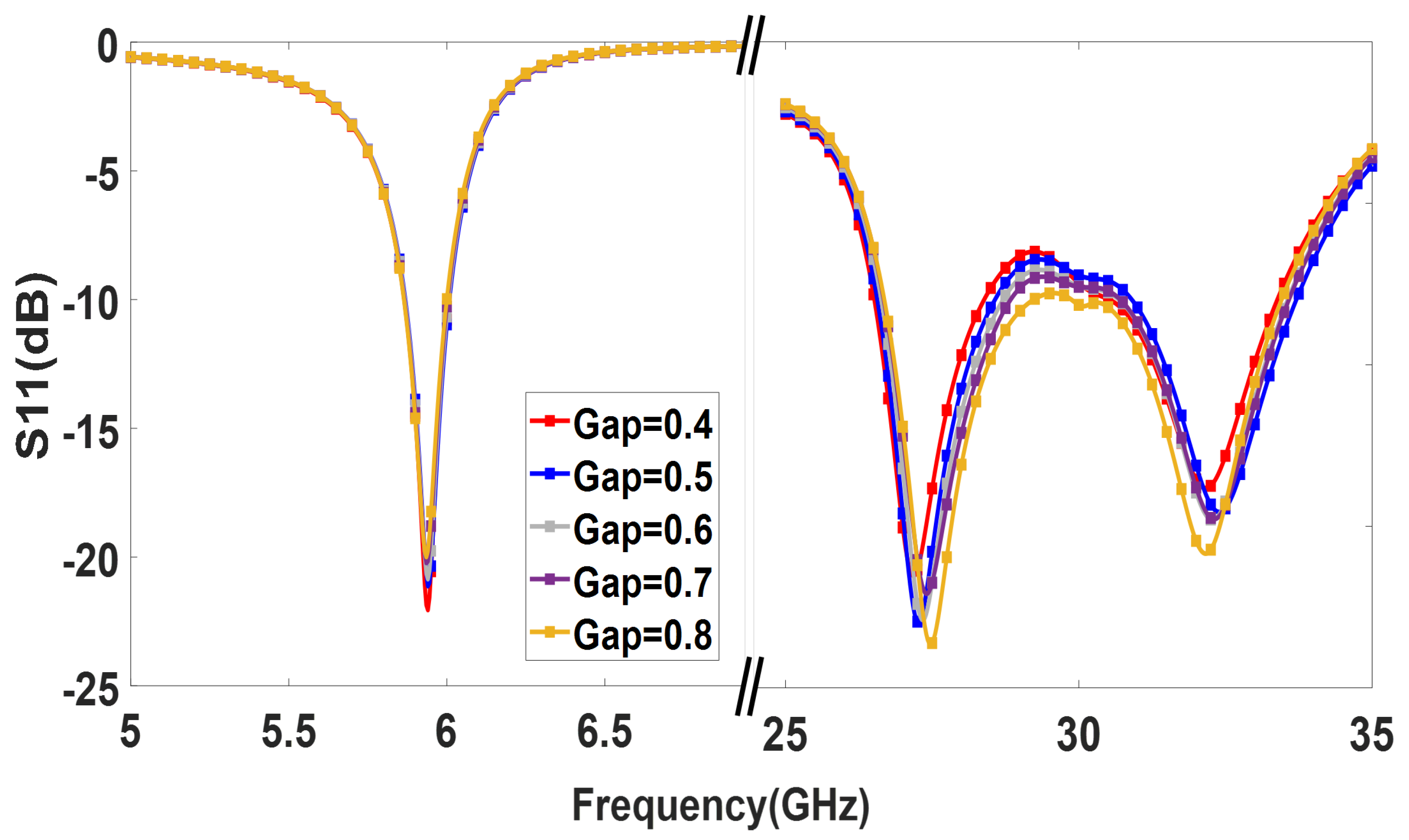
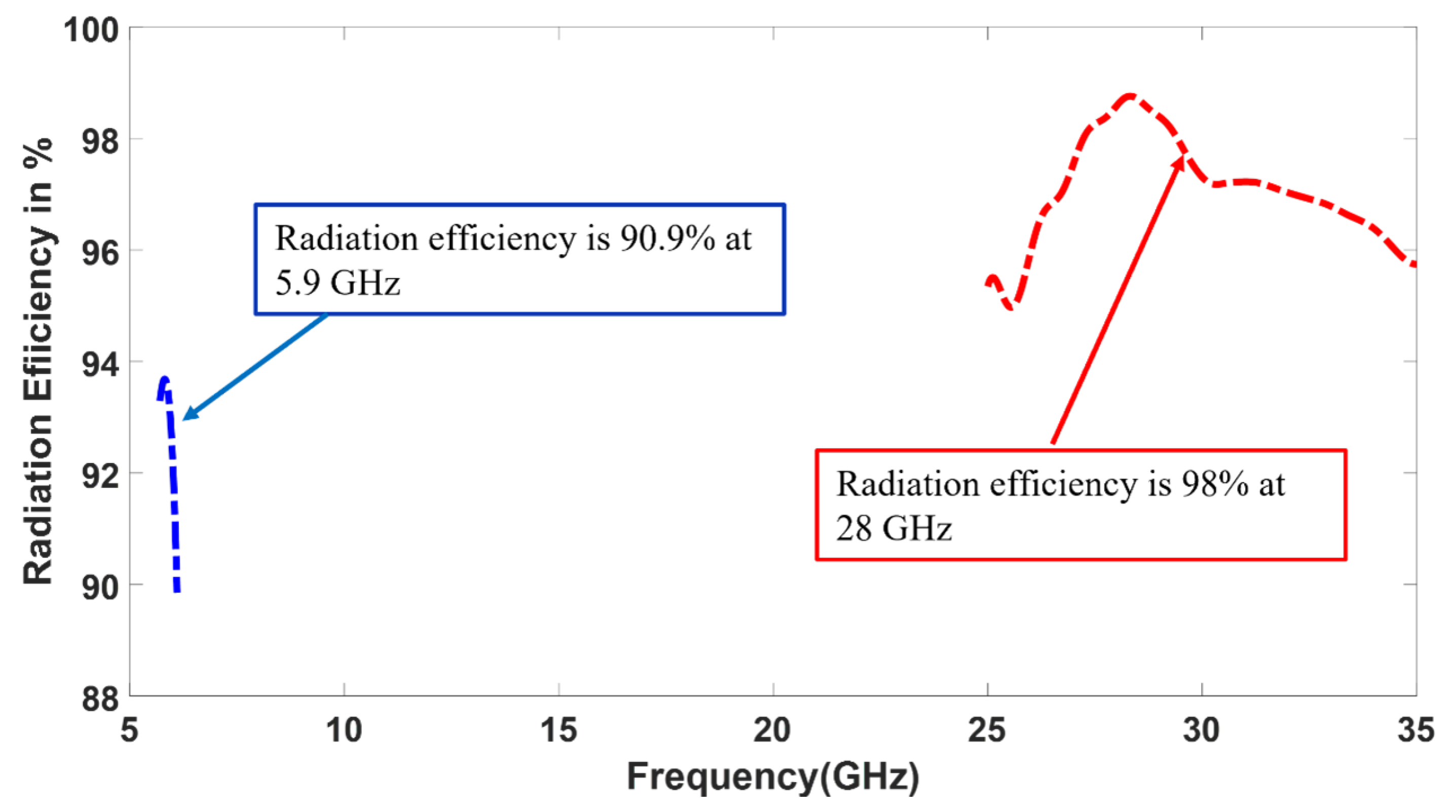
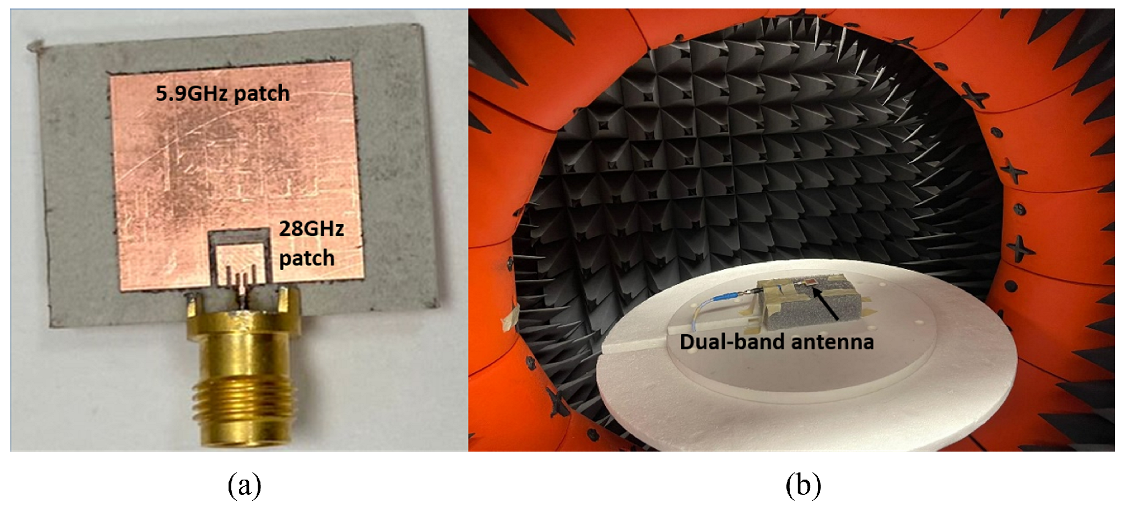


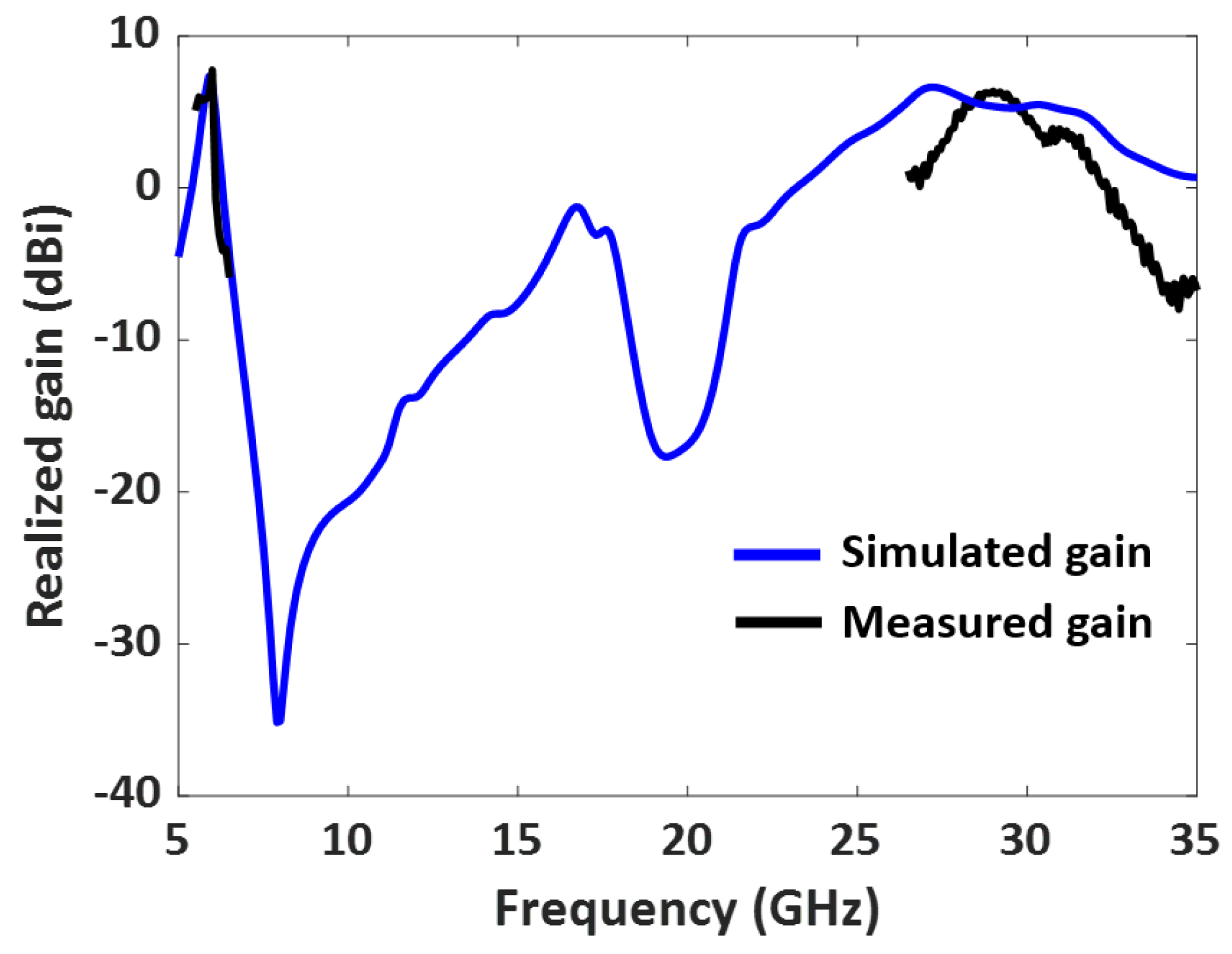

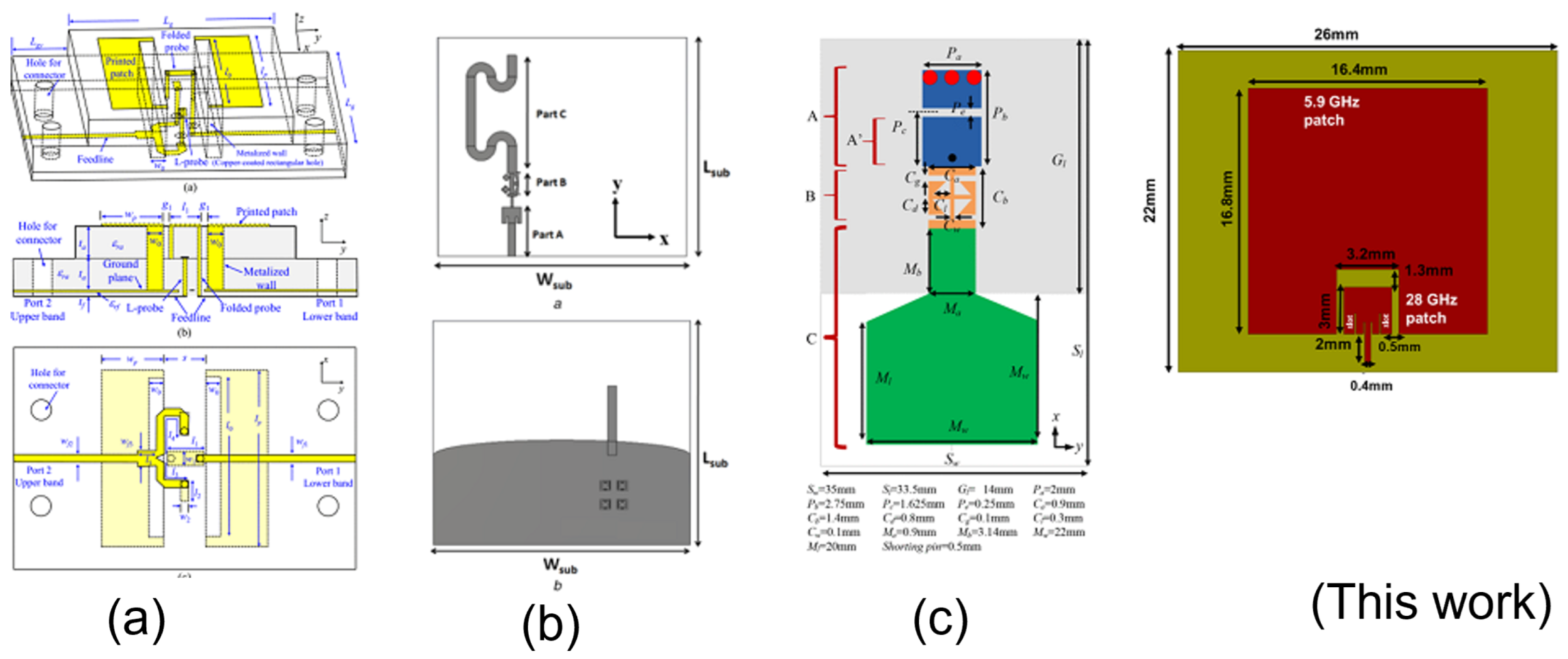
| DSRC Band | 5G mm-Wave Band | |
|---|---|---|
| Frequency | 5.9 GHz | 28 GHz |
| Impedance Bandwidth | 250 MHz | 4.5 GHz |
| Polarization | Linear polarization | |
| Peak Gain | 7.7 dBi | 6.38 dBi |
| HPBW | 92°/102° | 22°/63° |
| HPBW = Half Power Beamwidth | ||
| DSRC Band | 5G mm-Wave Band | |
|---|---|---|
| Simulated Frequency (GHz) | 5.81–5.99 GHz | 26.9–31.3 GHz |
| Measured Frequency (GHz) | 5.8–6 GHz | 26.8–31.6 GHz |
| Reference | [11] | [12] | [15] | [21] | This Work |
|---|---|---|---|---|---|
| Center Frequency(GHz) | 5.9 /28 | 2.4 /5.5 /28 | 2.4 /28 | 2.45 /60 | 5.9 /28 |
| Frequency Ratio | 4.74 | 11.6 | 11.6 | 24.4 | 4.74 |
| Operating Bandwidth | 47.1% /6.67% | 15.4% /22.2% /11.4% | 2.6:1 /8.9% | 2.5:1 /11.6% | 4.2% /16% |
| Dimensions ( × × ) | 0.65 × 0.43 × 0.12 | 0.36 ×0.32 × 0.004 | - | 0.28 ×0.38 × 0.002 | 0.43 × 0.51 × 0.025 |
| Peak Gain (dBi) | 5.8/8.46 | 1.95 /3.76 /7.35 | 2.6 /6.5 | 3 /6 | 7.7 /6.38 |
| No. of Ports | 2 | 1 | 1 | 1 | 1 |
| Harmonics Rejection | No | Yes | No | No | Yes |
Disclaimer/Publisher’s Note: The statements, opinions and data contained in all publications are solely those of the individual author(s) and contributor(s) and not of MDPI and/or the editor(s). MDPI and/or the editor(s) disclaim responsibility for any injury to people or property resulting from any ideas, methods, instructions or products referred to in the content. |
© 2023 by the authors. Licensee MDPI, Basel, Switzerland. This article is an open access article distributed under the terms and conditions of the Creative Commons Attribution (CC BY) license (https://creativecommons.org/licenses/by/4.0/).
Share and Cite
Govindarajulu, S.R.; Tarek, M.N.A.; Guerra, M.R.; Hassan, A.; Alwan, E. Modified U Slot Patch Antenna with Large Frequency Ratio for Vehicle-to-Vehicle Communication. Sensors 2023, 23, 6108. https://doi.org/10.3390/s23136108
Govindarajulu SR, Tarek MNA, Guerra MR, Hassan A, Alwan E. Modified U Slot Patch Antenna with Large Frequency Ratio for Vehicle-to-Vehicle Communication. Sensors. 2023; 23(13):6108. https://doi.org/10.3390/s23136108
Chicago/Turabian StyleGovindarajulu, Sandhiya Reddy, Md Nurul Anwar Tarek, Marisol Roman Guerra, Asif Hassan, and Elias Alwan. 2023. "Modified U Slot Patch Antenna with Large Frequency Ratio for Vehicle-to-Vehicle Communication" Sensors 23, no. 13: 6108. https://doi.org/10.3390/s23136108





